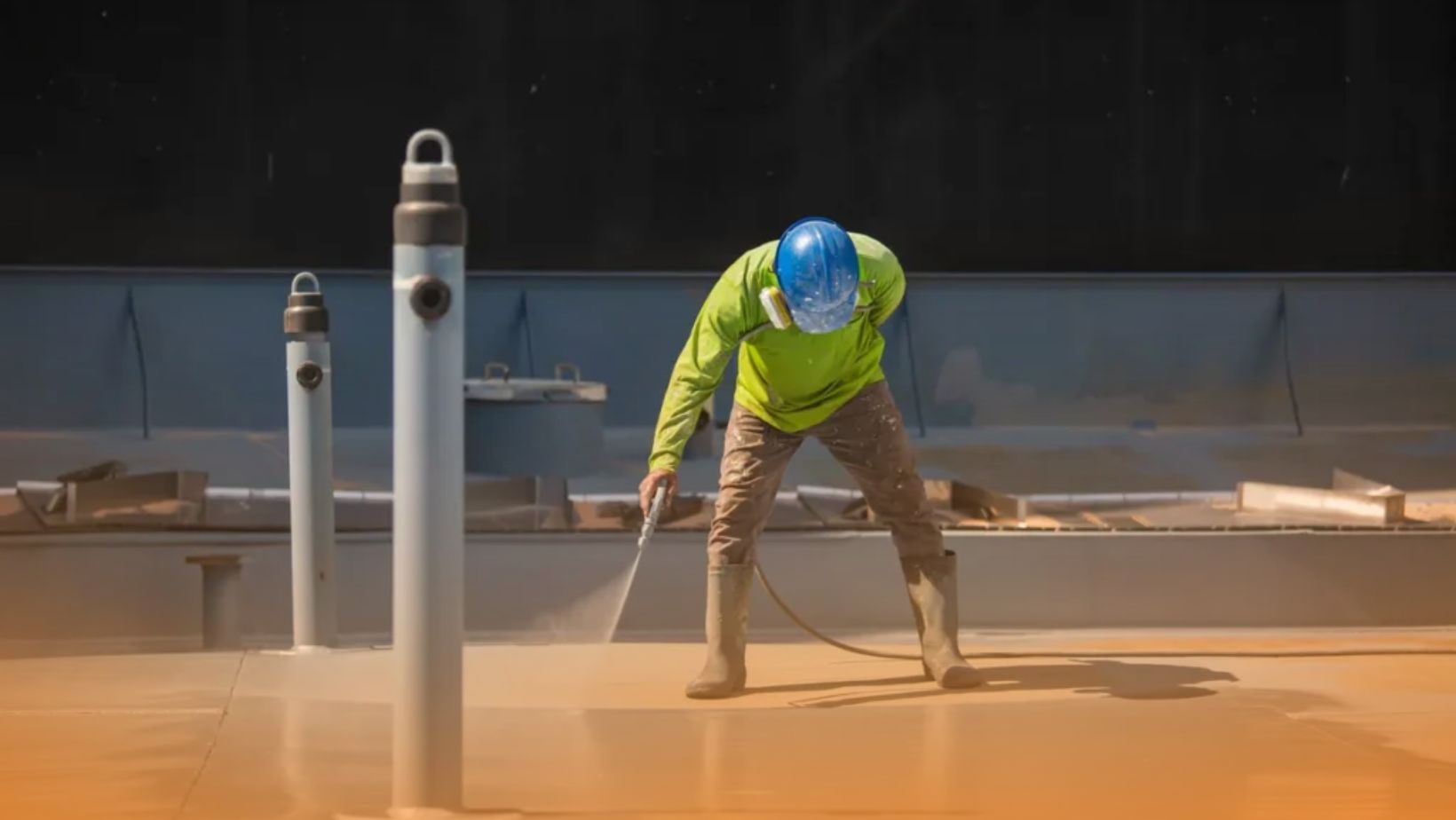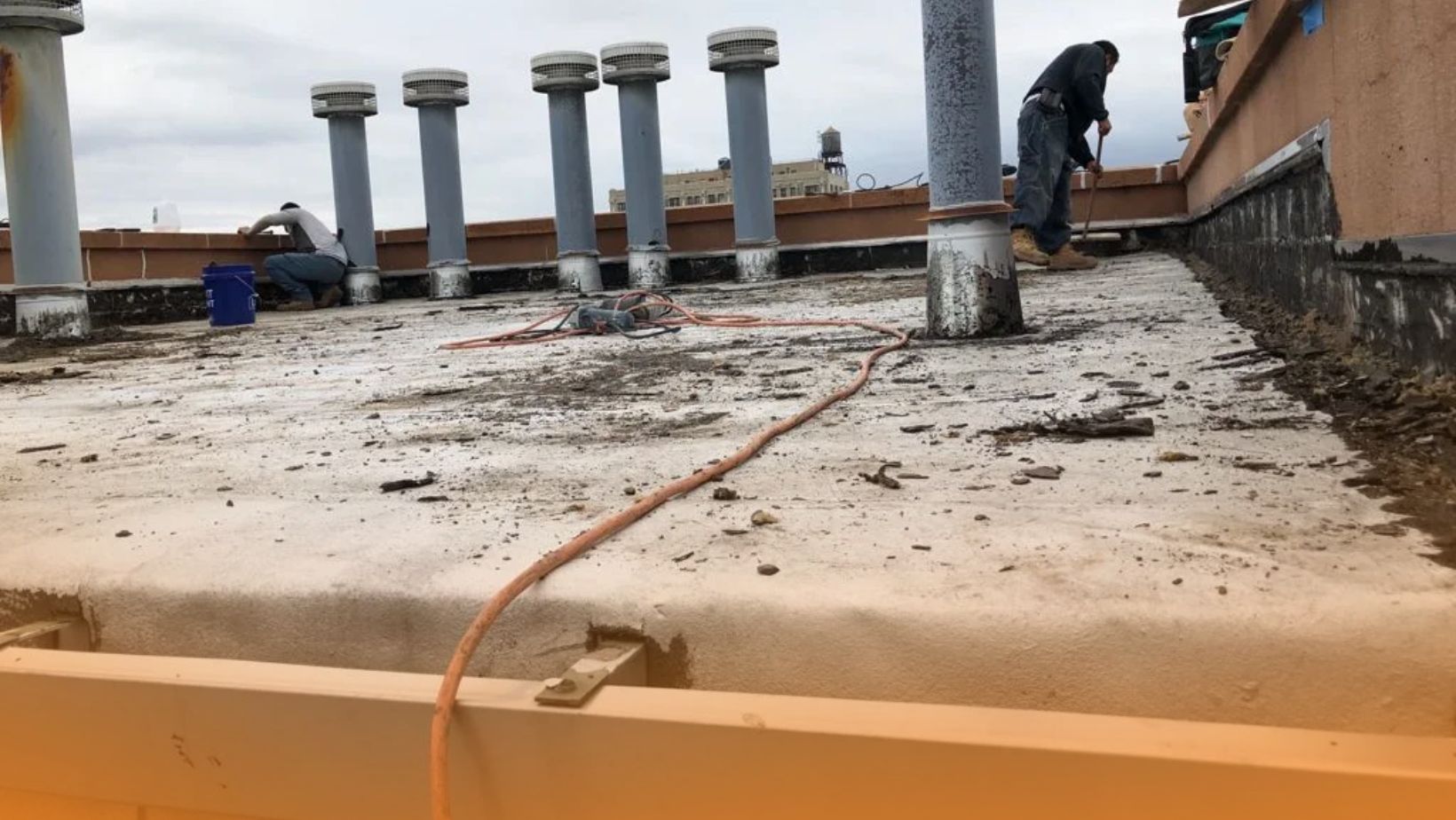Roofing systems are essential for protecting the structural integrity of commercial buildings, but what if there was a solution that could extend the life of your roof while providing numerous benefits? Enter the basics of SmartSeal’s commercial roof coatings— a game-changer in the world of roofing. These coatings not only enhance roof durability and longevity, but also offer waterproofing, UV resistance, and energy efficiency. Let’s explore the fascinating world of commercial roof coatings and how they can revolutionize the way you protect your building.
Key Takeaways
-
- SmartSeal’s Commercial roof coatings can extend the lifespan of a roof, improve performance and reduce energy costs.
-
- They provide waterproofing, leak prevention, UV resistance and energy efficiency benefits.
-
- Benefits include increased protection for low slope roofs, metal roofs & built up/single ply systems. Reduced rate of degradation due to UV rays & heat. Waste reduction from extended life & sustainable alternative.
The Importance of Commercial Roof Coatings
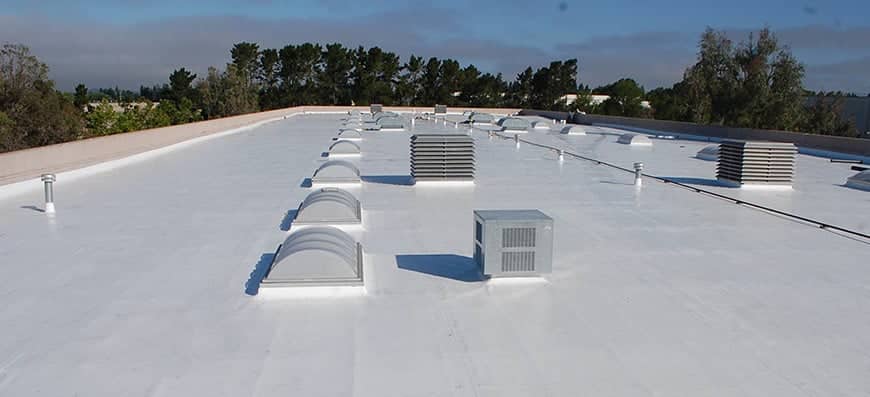
As a building owner, investing in commercial roof coatings can offer numerous benefits, including:
-
- Prolonging the lifespan of a roofing system
-
- Improving its performance
-
- Offering protection against various challenges like water intrusion, fire, and UV damage.
Moreover, they can save you money on insurance premiums, HVAC maintenance, and repair costs by reducing the roof’s temperature and keeping the building cooler during hot summer months. With various types of roof coatings available, such as acrylic, silicone, and polyurethane, there’s a solution tailored to every roof’s unique needs and benefits.
Waterproofing and Leak Prevention
A primary advantage of commercial roof coatings is the waterproofing and leak prevention they offer. These coatings provide the following benefits:
-
- Act as a barrier against water damage
-
- Shield the roof system and the building structure from potential harm
-
- Have a monolithic structure, self-adhering qualities, and flashing capabilities to impede water infiltration
-
- Ensure that your building remains dry and protected
This waterproofing feature is particularly beneficial for various roof surfaces, including:
-
- low-slope roofs
-
- metal roofs
-
- built-up roofing
-
- single-ply systems
Sealing the roof effectively and preventing leaks, SmartSeal’s commercial roof coatings can prolong your roof’s lifespan and protect your building from water damage and expensive repairs.
UV Resistance and Energy Efficiency
Commercial roof coatings offer several advantages, including:
-
- UV resistance: These coatings protect your roof from the sun’s harmful rays, which can accelerate roof deterioration and cause damage like cracking and warping.
-
- Energy efficiency: The coatings help regulate the temperature of your building, reducing the risk of damage caused by temperature fluctuations.
-
- Reflective properties: They work by reflecting the sun’s rays away from the roof.
This UV resistance and energy efficiency translate into reduced energy costs for building owners. The benefits of commercial roof coatings include:
-
- Maintaining a cooler roof surface and interior, leading to lower energy consumption and utility bills
-
- Significant energy savings
-
- A more comfortable indoor environment
Types of Commercial Roof Coatings: An Overview
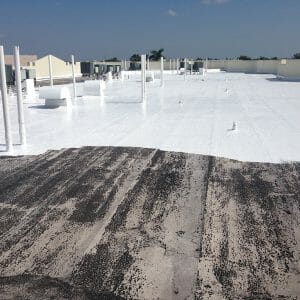
In the world of commercial roof coatings, there are three primary types to consider: acrylic, silicone, and polyurethane. Each type boasts unique properties and applications, making them suitable for different roofing situations.
We will explore each type in more detail and uncover their unique advantages.
Acrylic Coatings
Acrylic coatings are water-based and known for their versatility and customizable color options. They provide elastomeric qualities, allowing them to expand and contract with the roof, forming a seamless seal. This makes acrylic coating an ideal solution for various roof types, from low-slope to steep-slope roofs.
However, acrylic coatings have a few drawbacks, including a limited temperature range for application (50°F or higher) and a prolonged curing time (7 days). This can make planning and executing a project more challenging, especially in areas with unpredictable weather. Despite these limitations, acrylic coatings remain a popular choice for their durability, reflectivity, and energy efficiency.
Silicone Coatings
Silicone coatings are known for their weather-resistance, elasticity, and suitability for low-slope roofs. They offer superior waterproofing and UV protection compared to other types of coatings, making them ideal for roofs exposed to harsh weather conditions or intense sunlight. Silicone coatings are also highly resistant to ponding water, a common issue in low-slope roofs.
One of the most significant benefits of silicone coatings is their ability to reflect up to 80-90% of the sun’s harmful UV rays, preventing UV damage to the roof and extending its lifespan. This UV resistance also helps lower the roof temperature, reducing heat transfer into the building and contributing to energy savings.
Polyurethane Coatings
Polyurethane coatings are generally solvent-based. They can be divided into two main categories: aromatic and aliphatic. These coatings offer excellent mechanical properties, high abrasion resistance, and impressive tensile strength, making them ideal for high-stress areas or roofs with heavy foot traffic.
Aromatic polyurethane coatings provide good adhesion and weathering properties but are not UV-stable, making them more suitable as a base coat. On the other hand, aliphatic polyurethane coatings offer better UV stability, color retention, and resistance to dirt pick-up, making them an excellent choice for a topcoat.
With their high-performance characteristics, polyurethane coatings are a reliable choice for commercial roofs, especially in hail-prone regions or areas with heavy foot traffic.
Ideal Roof Types for Commercial Roof Coatings
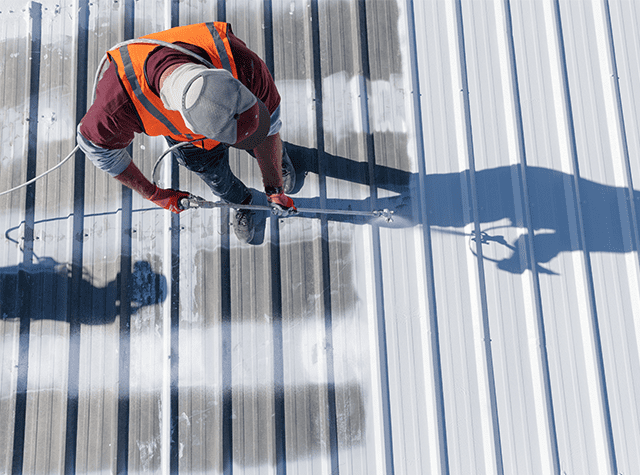
There is no one-size-fits-all solution when it comes to commercial roof coatings. Their effectiveness and suitability depend on the type of roof they are applied to. Ideal candidates for commercial roof coatings include:
-
- Low-slope roofs
-
- Metal roofs
-
- Built-up roofing
-
- Single-ply systems
We will investigate why these specific roof types gain the most from commercial roof coatings and how these coatings increase their protection and lifespan.
Low-Slope Roofs
Low-slope roofs, also known as roof slope, are particularly well-suited for commercial roof coatings due to their inherent challenges, such as inadequate drainage, improper installation techniques, and the requirement for specialized coverings. In contrast, steep slope roofing typically faces different challenges. Commercial roof coatings can provide essential waterproofing and UV resistance, addressing these issues and ensuring a longer-lasting roof for both low slope roofs and steep slope roofing systems.
Moreover, commercial roof coatings can help reduce the rate of roof degradation caused by UV rays and heat by:
-
- Reflecting and absorbing UV radiation
-
- Decreasing the amount of UV energy that reaches the roof surface
-
- Lowering the roof temperature
-
- Preventing damage such as cracking, warping, and early deterioration of the roof membrane.
Metal Roofs
Metal roofs are known for their durability and energy efficiency, making them a popular choice for commercial buildings. However, metal roofs are not immune to issues such as water infiltration, temperature fluctuations, and corrosion. Commercial roof coatings can help protect and maintain metal roofs by providing a waterproof barrier, reducing heat transfer, and enhancing UV resistance.
By applying a roof coating to a metal roof, building owners can extend the roof’s life and performance, ensuring that it remains protected from the elements. Furthermore, the reflective properties of commercial roof coatings can help reduce energy consumption and lower utility bills, making them an ideal solution for maintaining metal roofs.
Built-Up Roofing and Single-Ply Systems
Built-up roofing systems consist of multiple layers for enhanced protection, especially in extreme weather conditions and fluctuating temperatures. Single-ply systems, on the other hand, utilize materials like TPO, PVC, and EPDM and are designed to be applied in a single layer. Both of these roofing systems can benefit greatly from commercial roof coatings, which can extend their lifespan and enhance their overall performance.
By applying a roof coating to built-up or single-ply systems, property owners can:
-
- Protect their investment and ensure the longevity of their roof
-
- Provide a seamless, waterproof barrier that helps prevent leaks and other damage
-
- Reduce the need for costly repairs and replacements
-
- Minimize waste in the process
Commercial roof coatings offer these benefits and more, making a cool roof with a commercial roof coating an essential investment for your existing roof on your property.
Application and Maintenance of Commercial Roof Coatings
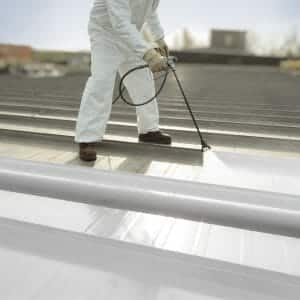
Despite the numerous benefits commercial roof coatings offer, their success hinges on the correct application and ongoing maintenance. From the initial inspection to the application process and ongoing upkeep, understanding the ins and outs of commercial roof coatings is essential to ensure their long-lasting performance and protection.
Application Process
Applying commercial roof coatings involves a series of steps, beginning with a comprehensive roof inspection to confirm its suitability for coating. Once the roof has been deemed appropriate, the surface must be adequately prepared by cleaning it to remove dirt and debris, repairing any leaks or damage, and allowing it to dry completely. In some cases, a primer may be necessary for enhanced adhesion, particularly for metal roofs.
Commercial roof coatings can be applied using various methods, such as spraying or rolling. Spraying is a more efficient method that requires specialized equipment and results in a uniform application, while rolling is slower and provides a thicker surface. The choice between spraying and rolling depends on the size and complexity of the roof area and the desired thickness of the coating.
Maintenance and Recoating
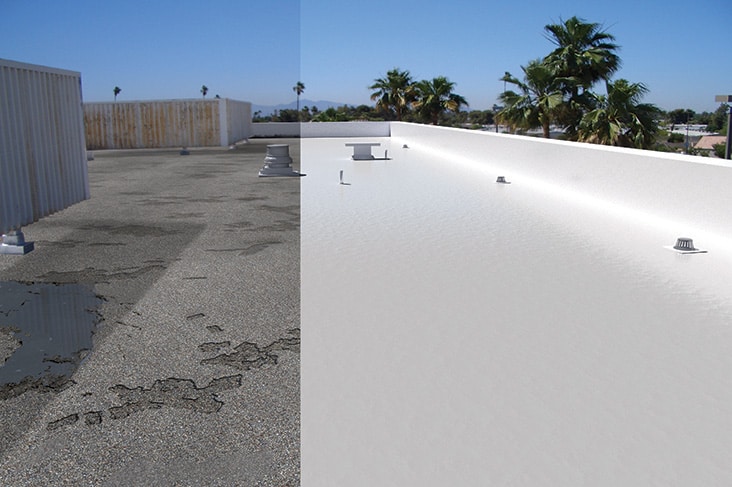
Regular maintenance is essential for extending the lifespan of commercial roof coatings. Here are some key steps to follow:
-
- Perform inspections at least twice a year, and more frequently after extreme weather events.
-
- Address any arising issues promptly to prevent further damage.
-
- Conduct necessary recoating to maintain the integrity of the roof.
-
- Regularly inspect for damage or leaks and ensure timely resolution.
By following these steps, you can ensure the longevity and effectiveness of your commercial roof coatings.
The timeline for recoating commercial roof coatings typically ranges between 10 and 20 years, depending on the type of coating and its upkeep. When it’s time to recoat, the process involves identifying the issue, thoroughly cleaning the area, and reapplying the coating until the surface is completely sealed. By adhering to a proper maintenance schedule and addressing issues promptly, building owners can maximize the benefits of their commercial roof coatings and ensure long-lasting protection.
Environmental Benefits of Commercial Roof Coatings

Besides offering multiple benefits for building owners, commercial roof coatings also promote a more sustainable and eco-friendly roofing solution. With their energy-saving and waste-reducing properties, commercial roof coatings are a responsible choice for those looking to minimize their environmental impact.
Energy Savings
Energy savings are greatly influenced by the reflective properties of commercial roof coatings. By reflecting heat and ultraviolet rays, these coatings help lower the roof temperature and reduce heat transfer into the building’s interior. This means less energy is required to cool the building, resulting in lower energy consumption and utility bills.
With commercial roof coatings, businesses can anticipate up to 25% energy savings, making them a wise investment for both the roof’s performance and the financial bottom line. By reducing energy usage, commercial roof coatings contribute to a more sustainable and eco-friendly roofing solution.
Waste Reduction
Traditional roof replacements are known to produce excessive waste, as estimated 11 million tons of waste asphalt roofing shingles are produced in the U.S. every year. Commercial roof coatings, on the other hand, promote waste reduction by extending the life of the roof and reducing the need for frequent replacements and disposal of roofing materials.
By delaying the requirement for costly roof replacements, fewer aged roofs are removed and discarded, resulting in less waste production. Moreover, roof coatings can help prevent leaks and other damage, further diminishing the need for repairs and replacements, and minimizing waste in the process.
In the end, commercial roof coatings provide a sustainable roofing alternative that is beneficial for both the building owner and the environment.
Summary
In conclusion, commercial roof coatings are a versatile and valuable solution for enhancing the performance, longevity, and protection of various roof types. Offering benefits such as waterproofing, leak prevention, UV resistance, and energy efficiency, these coatings can transform the way you protect and maintain your building. By choosing the right type of coating for your specific roof and adhering to proper application and maintenance practices, you can maximize the benefits of commercial roof coatings and contribute to a more sustainable and eco-friendly roofing solution. Make the smart investment in commercial roof coatings and experience the difference for yourself.
Frequently Asked Questions
What are commercial roof coatings?
Commercial roof coatings are a thick formula applied to existing roofing systems to extend their life and provide an extra layer of protection.
What are the different types of roof sealants?
The most common types of roof sealants are acrylic, asphalt, polyurethane, and silicone coatings. Additionally, other coatings such as coal tar, aluminum, and elastomeric-based coatings are also available.
What are the two main types of cool roof coatings?
The two main types of cool roof coatings are Aluminum Coatings, which provide 50-70% solar reflectance, and Pigmented Coatings, which reflect only 20% sunlight.
How do commercial roof coatings provide waterproofing and leak prevention?
Commercial roof coatings provide waterproofing and leak prevention by forming a seamless, monolithic barrier that prevents water infiltration, protecting the roof system from damage.
How do commercial roof coatings contribute to energy savings?
Commercial roof coatings improve energy efficiency through their reflective properties, reducing the temperature of the roof and decreasing heat transfer into the building, ultimately saving energy and money.


